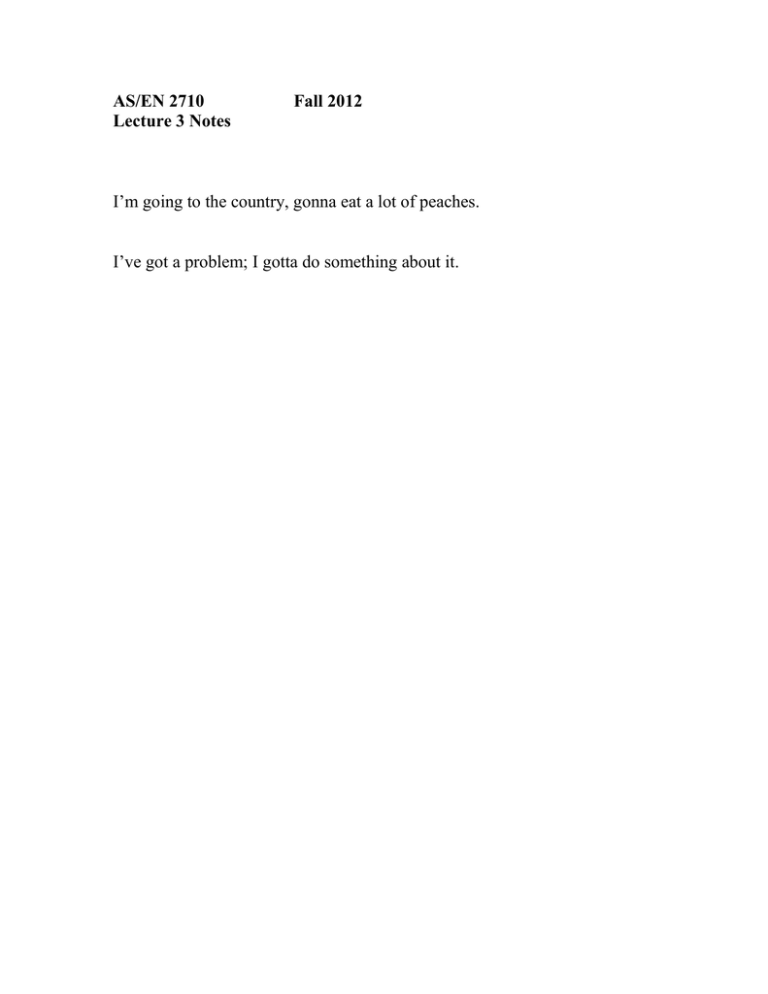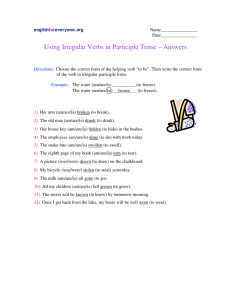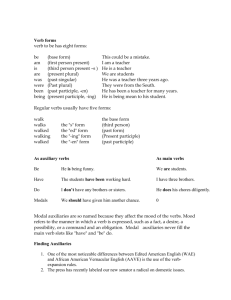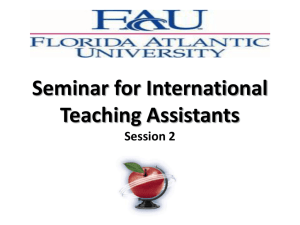2710-12-3ads
advertisement

AS/EN 2710 Lecture 3 Notes Fall 2012 I’m going to the country, gonna eat a lot of peaches. I’ve got a problem; I gotta do something about it. Reed-Kellogg Diagrams The proud city of Coriander repelled the besieging Ostrogoths. What is the main line? NP + VP (whether s.v.o. or s.v.complement) 1) Hard vertical going through the horizontal dividing NP from VP, divisions into grammatically separate slots on either side of this hard divide being marked by verticals that do not pierce the horizontal. Slots that complement other mainline items marked with a backslash. 2) If a complement is a prepositional phrase, it sits on a pedestal above the horizontal. 3) In all other cases, modifiers are added, initially at least, diagonally, attached to the horizontal line beneath the word they modify—this includes determiners, which are understood by the diagrammatic logic as being adjectival in their function. 4) Qualifiers of adjectives and adverbs are placed on diagonal lines attached to and parallel with the adjective. 5) Direct Objects are placed on the main horizontal line, Indirect Objects are attached beneath on a diagonal—that diagonal occupied by the preposition if a preposition is use and blank if the preposition is not, the object itself, or at least the object’s headword is place on a horizontal line, parallel to the main line. Tree diagrams The proud city of Coriander repelled the besieging Ostrogoths. 1) Leave sentences as they are arranged. S at the top marking the Sentence. 2) First branch marking subject and predicate NP (subject); VP (predicate) 3) Second branch breaking the NP and VP into their components, labelling first by part of speech, then by function as in PrepPh: Advreason. This second branching can have many stages butt it leads finally to 4) the last branch which labels each word by part of speech immediately above the word. Verb forms amo, amas, amat; amamus, amatis, amant (present indicative active) amor, amaris, amatur; amamur, amamini, amantur (present indicative passive) The five basic forms of the verb in English -s form -ed form -ing form -en form base (present) 3rd-person singular past present participle past participle ‘Twas brillig, and the slithy toves Did gyre and gimble in the wabe: All mimsy were the borogoves And the mome raths outgrabe. 7 types of Irregular Verbs www.usingenglish.com/reference/irregular-verbs/ 1) bend, bent, bent (change in consonant in p and pp, the latter two identical) also, build, have, make, learn, &c. 2) show, showed, shown (p. regular –ed form, pp. –en form often with “e” elided) also, mow, sew, shear, swell (swollen). 3) say, said, said (change in the vowel or the vowel sound) also hear, lost, feel, leap, &c 4) speak, spoke, spoken (no –ed form in the pm vowel change; -en form pp) also blow, hide, see, bite, write, &c 5) hit, hit, hit (all forms identical—some archaic –ed forms) also burst, hurt, fit, rid, cut, quit, put, &c 6) find, found, found (looks almost exactly like type 3 but does not have a –d or –t inflection in the simple past—many verbs of this type end in ‘d’ or ‘t’ to start with) also feed, read, bleed, fight, light, hang, &c 7) begin, began, begun (three different forms, neither an –ed, nor an –en inflection) also drink, sing, shrink, swim, &c. Base Past simple Participle / Gerund Past Participle Abide Alight Arise Awake Be Bear Beat Become Begin Behold Bend Bet Bid Bid Abode/Abided/Abidden Abides Alit/Alighted Alights Arisen Arises Awoken Awakes Been Is Born/Borne Bears Beaten Beats Become Becomes Begun Begins Beheld Beholds Bent Bends Bet Bets Bidden Bids Bid Bids Abode/Abided Alit/Alighted Arose Awoke Was/Were Bore Beat Became Began Beheld Bent Bet Bade Bid 3rd Person Sing. Present Abiding Alighting Arising Awaking Being Bearing Beating Becoming Beginning Beholding Bending Betting Bidding Bidding Usage moment: The worst irregular verbs. to lie: to be or stay at rest in a horizontal position; to be placed on a horizontal surface to lay: to cause to lie down; to place in or bring to a particular position; to put up to or again; to put forward as reproach or accusation Present Lie Lay Past Lay Laid Past Part. Lain Laid 3rd Sing Lies Lays Pres. Part. Lying Laying Auxilliaries the basic auxiliaries, be and have Have takes the –en form, the past participle, and that be takes the -ing for, the present participle, which is the meaning of their annoying little formula (have + -en) (be + -ing) MV Let’s also note that the have + -en form expressed completedness, even if that completedness has not yet occurred (hence perfect), while the be + -ing form expresses on-goingness even if that ongoingness has ended long since (hence progressive). Modals Which affect the “mood” of the verb conveying probability, possibility, obligation, intention, necessity, &c. There are 6 primary modal auxiliaries in English four of which have presents and pasts will/would; shall/should; can/could; may/might, and two that have no past form must and ought to. Subjunctive 1) conveys a strong, practically binding, suggestion or recommendation “While waving his stone-mason’s hammer, he suggested that the student turn off his cell-phone. Human Relations insisted that the hammer-wielding professor seek psychiatric help. In the end the tribunal decreed that the professor make full and appropriate restitution for smashing the cell-phone.” And 2) expressing a wish or a condition contrary to fact “If I were in Prof. Thor’s class, I’d turn that thing off. If Prof. Thor weren’t a monster raving loony, he might almost be amusing.” What disappears is the –s form for the third person singular and “were” replaces “was” in past forms of to be. Suggested verbs that work here: command, demand, ask, require, recommend, propose, and in the legislatives sense, move—all followed by a “that” clause employing the base verb form, Tense and aspect: two elements of temporality expressed in the form of the verb—as we’ve observed, in their auxiliary-free state verbs in English have only present and past tenses. To express any other relation to time than simple present or simple pastness, we have to expand the verb by growing words and forms around it. Hence: T (M) (have + -en) (be + -ing) MV The roster: simple present, past, present perfect, present perfect progressive, future, future perfect progressive present progressive, past progressive, past perfect, past perfect progressive, future perfect. How the test will be Students are asked to compose a coherent paragraph (or two, or more) that features the eighteen required grammatical elements enumerated below. Students are asked to identify the elements by placing the element’s assigned number in brackets immediately after its use. The grader will not guess. Successful use of each element will be valued at 5 marks. Partial grades may be assigned for inspired guesses but, in general, if it’s wrong, it’s wrong. The final 10 grades are discretionary for the grader and will evaluate the coherence of the paragraphs as a whole. That is, a series of eighteen unrelated, random sentences might obtain 90/90 for being wholly correct. It will, however, receive 0/10 for coherence. Students will employ: • two distinct forms, other than the base (including the past participle) of two of the following irregular verbs (#1-4) • one instance of each of the following verb tenses/aspects (#5-7) • one instance a phrasal (multiple-word) auxiliary (# 8) • two passive constructions one of which must be in a tense other than the simple present (#9-10) • two uses of the verb do, once as a modal and once as a pseudo-auxiliary (#11-12) • one instance of each of the following moods (# 13-14) • one instance each of a subject complement and an object complement with a verb other than to be (#15-16) • two instances of the mystery element (#17-18). This one will be named on the actual test but it’s the one thing you could actually prepare in advance. Autumn begins today. Summer ended yesterday. I am teaching AS/EN 2710 this term. I teach AS/EN 2710. I am trying to keep this interesting. I was trying to make this stuff less dull, but have now given that up. Elvis had abandoned all hope of rescue even before he smelt the python’s breath. The snake had been fasting contentedly for weeks until the scent of rank adventurer’s sweat whet his appetite. Perhaps I will dine tonight, he thought, I will have digested the last of that capybara before the corpse starts properly to rot.






